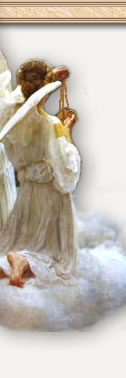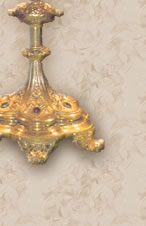




 |
|

|
|
|||||||||||
|
|
|
|
||||||||||||
 |
|
|
||||||||||||
 |
|
 |
|
|||||||||||
|
|
||||||||||||||
 |
 |
|
|
|
|
The Buck Stops Where?
When asked to submit this article for The Latin Mass magazine, I was more than a little hesitant. My interest in the subject, however, convinced me to accept the invitation. The topic was a challenge, and fairly intimidating. I determined to approach it by musing and reflecting on my own life in the priesthood these past twenty-five years. This, therefore, will not be the polished product of a scholar, but rather the thoughts of a veteran of both the “trenches” and the “sidelines.” Some of what I write will upset a goodly number. I wasn’t certain where I would begin, until someone jarred memories of my father, deceased now many years. Something he used to say fairly often to us as we grew and matured came back to me. I was able to be at home with my folks intermittently during my dad’s final illness. We were watching the evening news and the broadcast included what is now a tragically familiar type of clerical scandal in our diocese. What made it more painful was that it involved our old parish. Dad was visibly angry and deeply disturbed. In his own quiet way he deeply loved the Church and his faith. His common sense questions and commentary continued through the broadcast that related one ecclesiastical blunder after another. I attempted to calm him with what I knew in my heart were bland platitudes and excuses. In the face of his simple logic, the common sense of the common man in the pew, I was silenced and remained mute as he verbally rejected my effort to diffuse his outrage with my feeble “party line.” He concluded with an impassioned plea for sanity and some reasonable holiness and honesty in the Church with words similar to these: “I always raised you kids with a keen sense of responsibility. If anything went wrong in this household the buck stopped here…with me. For good or for bad I have the duty and obligation to be answerable for the stewardship of my family. You can always run from it, but you cannot hide. And for all of you, and for your mom and me, the buck stops here,” as he pointed to himself, well on his way to eternity. There really wasn’t anything I could say. In his straightforward and simple way, my father had exposed the ineptitude, deception and dishonest way by which the local ordinary had handled the clerical scandal, insulting and abusing his flock in the process. The financial repercussions would cost hundreds of thousands of dollars that would be paid by the Catholic in the pew. The cost in terms of faith and trust would be incalculable. Remembering that incident began my reflections about the past thirty-plus years of life in the post-conciliar Church. Try as I may, even though I can glimpse the good God has afforded through these years, I cannot overcome an overwhelming sense of disaster and sadness as events continue the Church on its downward spiral. I keep asking myself, “Where does the buck stop in the Church?” Who is ultimately responsible for the crisis through which we have lived and which we continue to experience? I read statements by Roman curial officials that, in effect, are saying, “Somehow we have lost our way.” The Church doesn’t exist in a vacuum. Throughout the past forty years a multitude of voices, clerical and lay, have been raised against much of the tragedy that has been permitted to continue to infect and destroy, even before its existence was generally admitted by most of the Church’s leadership. Pope Paul VI lamented that the Church was in an “autodestruct mode.” Yet, after he requested the input of his own bishops regarding the new liturgy, he rejected it. He even ignored a petition that had been signed by some of the most prominent figures in Western culture (many of whom were non-Catholic and even non-Christian), begging that the Tridentine Mass remain normative for the worship of the Church. Why? Pope Paul waited nearly five years after the Papal Birth Control Commission arrived at its “Majority Report” before he finally issued Humanae Vitae, the great Magna Carta of human dignity and worth. Yet, by his long silence, he permitted five years of doubt, confusion, arguing, challenging. Why? The damage done to souls was incalculable. Even after the appearance of the encyclical, dissent was permitted to continue. Why? During my seminary years, which spanned the 1960s and the
early 1970s, every Roman instruction was hailed as an
“authentic” interpretation of a conciliar document. Particularly
in the field of liturgy, however, each so-called clarification
contained further ambiguities. Eventually, these
“clarifications” began to canonize the very abuses that previous
“clarifications” were supposed to address and rectify! But is it? What will it accomplish? After eleven years of haggling between the Holy See and the NCCB, Ex Corde Ecclesiae is a dead letter (despite the optimism of the conservative Catholic intelligentsia). What makes anyone think that LA will be any different? The conservative Catholic intelligentsia has ranted and raved
that the liturgical machinations of ICEL (International
Commission on English in the Liturgy) has been the “big bad
wolf.” But who from the beginning has approved every ICEL
translation? Rome, of course. Paragraph six of LA speaks of
previous errors and omissions. What are they? On whose watch did
they occur? Where does the buck stop? Paragraph eight of the
same document states that this instruction is to replace all
previously issued instructions. Were the previous documents not
authentic? Is this just another instance of the foxes watching
the hen house? LA speaks of the “Roman rite.” Why not “rites,” seeing as there are four Eucharistic Prayers (Canons), plus all the other Masses for children and reconciliation? The plethora of options makes harmony and unity virtually impossible. Besides, what is the point of any Roman liturgical legislation when one may be virtually certain that any given pontifical liturgy will ignore legislated norms: pottery for sacred vessels, curious texts, and odd behavior. (Bare-breasted women readers, I assume, most would agree is odd.) My purpose is not to condemn. I am pleading for honesty. The
decision to permit female altar servers contradicts
Inaestimabile Donum, yet the author of that document regularly
contradicts its contents whenever he insists that serving Mass
is a way for women to take their proper role in the Church.
Constantly and consistently, Rome acts and speaks as if the
principle of non-contradiction has become extinct: countless
martyrs died refusing to compromise the Faith, yet the present
Supreme Pontiff venerates the Koran. Countless missionaries have
offered their lives to convert pagans, yet today the Vicar of
Christ submits to ritual pagan blessings. Traditional Catholics are ostracized for their criticisms of ecclesial ambiguities forged at the Second Vatican Council. Yet, during the past thirty years, every previous Council has been relativized by the insistence of Roman-approved theologians that their fruits were time-bound and historically conditioned. But such notions relativize Vatican II! Of course, to be fair, some contemporary modernist theologians are being consistent. They agree that Vatican II is already outdated, and that the Church has “moved beyond” the now-dated conciliar documents. Meanwhile, the neoconservative theologians are trying to settle the question as to what the conciliar documents actually said! Hello? Anybody home? The nature of the crisis is painful. The scenario for a solution is difficult to imagine, much less articulate. There is a need to put the past thirty years of this nightmare behind us. We should acknowledge that, despite the good will of some, it is necessary that we recognize the colossal tragedy, and move forward. A liturgical “reform of the reform” is not viable: it would be the equivalent of placing a Rolls Royce body on a Yugo engine block. Those of this opinion (generally labeled as traditional Catholics), require a Metropolitan Archbishop. This office could be established along the lines of the Eastern Churches. Such a canonical arrangement would permit traditional Catholics the freedom of their own internal governance in communion with the Holy See, the traditional liturgy, and an ecclesial structure that would be compatible with classic Catholic spirituality and theological presuppositions. The fighting and bitterness would end. All the human energy and effort, finances and other resources would be better directed and more efficaciously applied within the life of the Church. It’s time for Rome to understand that, regardless of her original and even good intentions of the past thirty-plus years, staggering numbers of Catholics have been alienated, ostracized, and are increasingly persecuted by ever-suspicious, resentful and vituperative diocesan bureaucracies. The Holy See needs to be as sincere and generous with traditional Catholics within the fold as it is with those outside of it. Initiating the above canonical solution would signal a fatherly understanding of their predicament, and bring hope and renewed vigor to millions of long-suffering and debilitated priests and faithful. These are approaching an ecclesial exhaustion born of the tensions of being misunderstood and betrayed by men called by their office to be spiritual fathers. Let us accept reality: neither side in this long and protracted Thirty Years War will surrender. For the good of the Church, and for the sake of the charity and freedom about which St. Augustine so eloquently speaks, permit traditional Catholics their own life and ecclesial governance in communion with the Bishop of Rome. Justice, as the Church has always proclaimed, demands it, charity requires it, the natural law demands it. Let the buck stop here. Duc in altum! Fr. Christopher Slattery is a religious monk in the United States. |
|



♦ About The Mass ♦ Resources ♦ How To Help ♦ Contact Us ♦